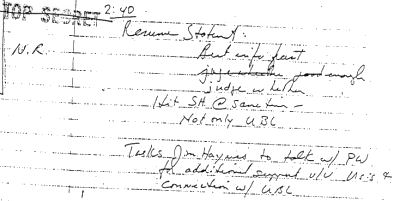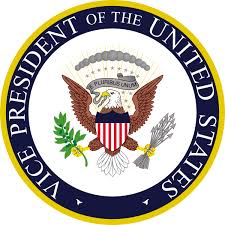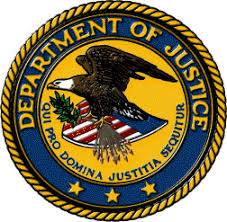Four documents in the immediate post-9/11 days set the tone for what was to follow – two public and two private.
KEY DOCUMENT 5: Lest one questions that the Bush Administration had its eyes on invading Iraq, Donald Rumsfeld’s notes on the afternoon of 9/11 make things abundantly clear. "Hit SH [Saddam Hussein] @ same time – Not only UBL [Osama Bin Laden]."
 Secretary of Defense, Donald Rumsfeld 2:40 PM September 11, 2001 |
 |
KEY DOCUMENT 6: Within a few days, Vice President Cheney was the official spokesman, appearing on Meet the Press. He didn’t exactly implicate Iraq. It was also the interview that introduced his idea of "the dark side." I don’t think we had any idea what he meant at the time. Like all Americans, we were all in shock and his words were comforting. We didn’t know that what was coming was the kind of "dark side" that would have us looking at the photos from Abu Ghraib. I guess we thought the dark side meant meeting with shady characters in the Casbah or something out of a James Bond Movie, and it would take a while to know what those words really meant.
 VICE PRESIDENT: DICK CHENEY
SEPTEMBER 16, 2001 MEET THE PRESS
MR. RUSSERT: Saddam Hussein, your old friend, his government had this to say: "The American cowboy is rearing the fruits of crime against humanity." If we determine that Saddam Hussein is also harboring terrorists, and there’s a track record there, would we have any reluctance of going after Saddam Hussein?
VICE PRES. CHENEY: No.
MR. RUSSERT: Do we have evidence that he’s harboring terrorists?
VICE PRES. CHENEY: There is – in the past, there have been some activities related to terrorism by Saddam Hussein. But at this stage, you know, the focus is over here on al-Qaida and the most recent events in New York. Saddam Hussein’s bottled up, at this point, but clearly, we continue to have a fairly tough policy where the Iraqis are concerned.
MR. RUSSERT: Do we have any evidence linking Saddam Hussein or Iraqis to this operation?
VICE PRES. CHENEY: No…
VICE PRES. CHENEY: I’m going to be careful here, Tim, because I – clearly it would be inappropriate for me to talk about operational matters, specific options or the kinds of activities we might undertake going forward. We do, indeed, though, have, obviously, the world’s finest military. They’ve got a broad range of capabilities. And they may well be given missions in connection with this overall task and strategy. We also have to work, though, sort of the dark side, if you will. We’ve got to spend time in the shadows in the intelligence world. A lot of what needs to be done here will have to be done quietly, without any discussion, using sources and methods that are available to our intelligence agencies, if we’re going to be successful. That’s the world these folks operate in, and so it’s going to be vital for us to use any means at our disposal, basically, to achieve our objective.
MR. RUSSERT: There have been restrictions placed on the United States intelligence gathering, reluctance to use unsavory characters, those who violated human rights, to assist in intelligence gathering. Will we lift some of those restrictions?
VICE PRES. CHENEY: Oh, I think so. I think the – one of the by-products, if you will, of this tragic set of circumstances is that we’ll see a very thorough sort of reassessment of how we operate and the kinds of people we deal with. There’s – if you’re going to deal only with sort of officially approved, certified good guys, you’re not going to find out what the bad guys are doing. You need to be able to penetrate these organizations. You need to have on the payroll some very unsavory characters if, in fact, you’re going to be able to learn all that needs to be learned in order to forestall these kinds of activities. It is a mean, nasty, dangerous dirty business out there, and we have to operate in that arena. I’m convinced we can do it; we can do it successfully. But we need to make certain that we have not tied the hands, if you will, of our intelligence communities in terms of accomplishing their mission.
|
KEY DOCUMENT 7: Within a week, Congress authorized the use of Military force to deal with the perpetrators of the 9/11 attack on New York. It passed 420:1:2 in the House and 98:0:2 in the Senate. Notice the wording. It’s broad ["planned, authorized, committed, or aided…" "or harbored such organizations or persons"], but specific ["the terrorist attacks that occurred on September 11, 2001"].
|
JOINT RESOLUTION
To authorize the use of United States Armed Forces against those responsible for the recent attacks launched against the United States.
Resolved by the Senate and House of Representatives of the United States of America in Congress assembled,
SECTION 1. SHORT TITLE.
SEC. 2. AUTHORIZATION FOR USE OF UNITED STATES ARMED FORCES.
(a) IN GENERAL- That the President is authorized to use all necessary and appropriate force against those nations, organizations, or persons he determines planned, authorized, committed, or aided the terrorist attacks that occurred on September 11, 2001, or harbored such organizations or persons, in order to prevent any future acts of international terrorism against the United States by such nations, organizations or persons.
(b) War Powers Resolution Requirements-
(1) SPECIFIC STATUTORY AUTHORIZATION- Consistent with section 8(a)(1) of the War Powers Resolution, the Congress declares that this section is intended to constitute specific statutory authorization within the meaning of section 5(b) of the War Powers Resolution.
(2) APPLICABILITY OF OTHER REQUIREMENTS- Nothing in this resolution supercedes any requirement of the War Powers Resolution.
Approved September 18, 2001.
|
KEY DOCUMENT 8: At the time, probably none of us had ever heard of the O.L.C. [Office of Legal Counsel] in the DoJ. We certainly never heard of this Memo. If you read it carefully, the questions have to be, "Why was it written? What was ambiguous about the broad powers Congress gave to the President?" The second paragraph seems to simply reiterate the wording of the AUMF itself. But the third paragraph is a gigantic leap ["…deploy military force preemptively against terrorist organizations or the States that harbor or support them, whether or not they can be linked to the specific terrorist incidents of September 11"]. You will have to read the whole thing to try to follow Yoo’s logic. So, we didn’t know about this rewriting of the AUMF because it was a secret, but in these few words, the specificity of the Congressional Act was destroyed. This was the beginning of a pattern of rewriting and reframing Congressional actions to expand Presidential powers by unobserved OLC Memos or Signing Statements that would continue unabated throughout the Administration’s tenure. And why make these assertions? It seems easy to see now that the door was being opened for the Invasion of Iraq [and maybe more], but at the time, neither Congress nor the people knew about what was happening..
|
The President has broad constitutional power to take military action in response to the terrorist attacks on the United States on September 11, 2001. Congress has acknowledged this inherent executive power in both the War Powers Resolution and the Joint Resolution passed by Congress on September 14, 2001.
The President has constitutional power not only to retaliate against any person, organization, or State suspected of involvement in terrorist attacks on the United States, but also against foreign States suspected of harboring or supporting such organizations. The President may deploy military force preemptively against terrorist organizations or the States that harbor or support them, whether or not they can be linked to the specific terrorist incidents of September 11…
September 25, 2001
|


Thanks, Mickey, for this very helpful compilation of the crucial statements and happenings. It really helps to get the whole thing clear.